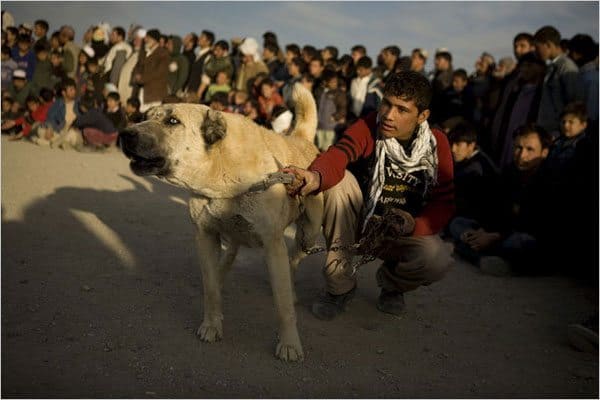If you like The Dog Files please join our Facebook Fan Page at http://www.facebook.com/dogfiles
Also, follow us on Twitter at http://www.twitter.com/dogfiles

 By Thane Burnett, Torontosun.com
On the weekly day of rest in Afghanistan, the dogs are brought out to fight.
Cars and people form a haphazard fighting ring on the outskirts of Kabul most Fridays of these colder months, and against deafening barks and newfound freedom, lowly shopkeepers and fearsome warlords battle on even ground.
Or at least their hard honed beasts do.
As soldiers — including Canadian troops — rise and sometimes fall to protect personal rights like education for young girls and a burgeoning sense of democracy for all, the men of Afghanistan have welcomed back the ancient blood sport of dogfighting.
And over the past few years of its resurgence, there’s been few cries of condemnation from outsiders for a practice the hard-lined Taliban had previously banned as un-Islamic.
“It’s a sensitive issue,†admits Christopher Sainsbury, of Mayhew Animal Home (mayhewanimalhome.org), one of the UK’s busiest animal sanctuaries.
Last year, working as Mayhew International, the agency helped Paul “Penny†Farthing, a former British marine, rescue an Afghanistan dog groomed for fighting. The animal, “Bear”, was later adopted in Britain — one of almost 50 dogs from Afghanistan that have found homes abroad. There are plenty of strays in England, so the highly publicized canine liberation was meant as a way to bring attention to wider concerns.
But Mayhew and other animal rights groups are faced with a reality as tough as the mountain dogs raised to fight. In a country where honour is found in battle, how do you tell a man that — like the oppressors you fight to free him from — you want to deny him a past-time his forefathers enjoyed.
“It’s being rediscovered,†Sainsbury explains of previously outlawed conflict sports, where participants fight using everything from dogs to camels to birds to kites.
Sainsbury says Mayhew keeps tabs on the dogfights held in most major cities in Afghanistan, but isn’t actively trying to have them banned. Instead, they are targeting more widespread practices, including the habit of communities tossing out poisoned meat for stays at dusk — a time when the dogs and feral cats believe they are safest.
Their carcasses are picked up by morning, as the harsh animal control efforts roll on to the next night.
Animal rights activists have also tried to question, not the fights, but the way the dogs are groomed for combat. In some cases — as it was with Bear, who was brought to the U.K. last year — wire or scissors are used to cut tails, and even long ears.
Even beyond fighters, this practice is common among owners.
But the effort of educating a war weary population is slow, especially as locals find welcomed relaxation and a bit of needed profit in wagering over dogfights.
“The people don’t always want to listen,†Sainsbury points out, but believes time, education and access to wider views on humane animal treatment will see the dog brawling decline.
But not any time soon. Perhaps not for another generation, he laments.
Rafal Gerszak, a Canadian photojournalist who covers Afghanistan (rafalgerszak.com), says the matches are taken so seriously, he recalls one owner — as Afghanistan police provided crowd control — losing his $30,000 SUV in a bet.
Gerszak has even felt the sharp bite of the sport, when he nudged too close to one of the dogs while photographing spectators.
And while he doesn’t condone the spectacles, he understands the cultural significance and adds: “The owners really care about (the animals).â€
Matches don’t end in death, he notes, but with dominance.
Former British Marine Sergeant Farthing — who returned to Afghanistan last November as a civilian to work on the dog rescue charity he’s started (nowzaddogs.co.uk) — began his campaign while stationed in the hot-zone of Nowzad.
“Looking after the dogs was our moment of escapism,†he recalls in an email exchange with QMI Agency.
A tough soldier who owns one of the Afghanistan strays — not all were involved in fighting — he also sees the benefits of not challenging the Afghan people on the morality of pitting dog against dog.
“The best way to make enemies with another culture is to impose our own so called righteous culture,†he says, noting the numbers of underground dogfights in the UK and North America.
“I have to admit, sad as it is, that I can achieve more for animal welfare in Afghanistan with the tribal leaders on my side than if I focus on banning dog fighting.
“One day, but not yet.â€
While it may seem strange that Western views and Taliban laws agree on having the dogfights fade to history, Farthing says diplomacy and education are the only answers.
After all, he points out, when the Taliban banned the sport, the penalty seemed rather inhumane.
The punishment for organizing a dogfight, Farthing points out, was death.
